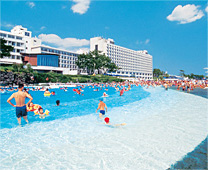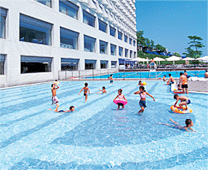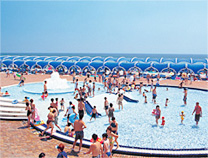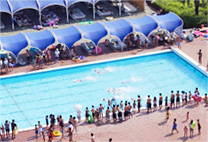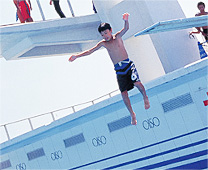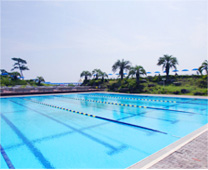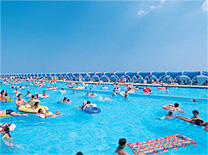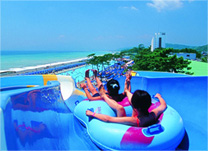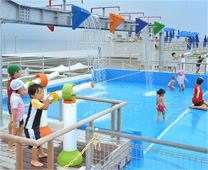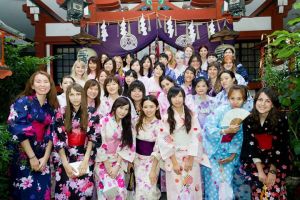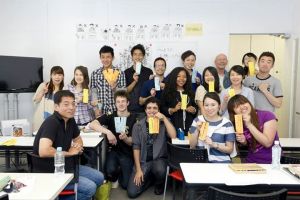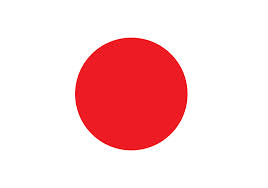The summer months (June to August) are dominated by warm, moist air currents from the Pacific, and produce high temperatures and humidity throughout most of Japan (with the blissful exception of Hokkaidō). In the early part of summer, usually mid-May to June, there is a rainy season lasting a few weeks that starts in the south and gradually works its way northward. Although it can be inconvenient, this rainy season is not usually a significant barrier to travel. August, September and October is typhoon season, which can make travel in Okinawa, the Izu-shotō and Ogasawara-shotō difficult.
Because of the hot weather, Japanese people beats the summer heat depression by doing fun activities under the sun.
Sea/ Ocean activities
Diving and Snorkeling
Diving and Snorkeling in Japan waters is good but not on the level of the Caribbean or Fiji. The water is sometimes cold and the visibility in many places at best is around to 30 to 50 feet. What makes diving in Japan interesting though is you can see sea life and natural wonders found nowhere else in the world.

There are PADI-member dive outfitters located in many places in Japan. They offer air filing, gear rentals, instruction and transportation to the diving areas. Snorkeling is usually offered on the same boat trips that take scuba divers out but snorkelers often see a lot less.
For more information about diving contact PADI International (Website: PADI ) 1251 East Dyer Road #100, Santa Ana, CA 92705-5605, ☎ 714-540-7234). In Japan, you can buy diving and snorkeling guides.
Dive Sites : The Japanese are enthusiastic divers and will dive pretty much anywhere. Japan has 6000 mile of coastline and the dive sites include reefs, freshwater pools, caves, wrecks, kelp forests, unique fjords and abalone beds.
The main dive sites are in Okinawa and the islands between Okinawa and Taiwan.
Okinawa contain some of the world’s northernmost tropical coral reefs and a great variety of coral. Thus far 370 different species of coral and 1,000 species of reef fish have been counted. Coral bleaching has become a problem in some places.
On the Main Island some visitors take glass bottom bota trips and walk on the bottom of the ocean in weighted boots with headgear connected to an oxygen hose. Some of the best snorkeling and diving os on the nearby small islands of Iheya-jima, Izena-jima. Kume-jima and the Keram-retto Islands.
The best coral reefs are off Ishigakjima and Iriomotejima. Three-kilometer-long Shiraho reef off Ishigaki Island contains at least two thirds of the number of species found in Australia’s Great Barrier Reef and some world’s largest, oldest and finest colonies of blue coral.

Manta ray in OkinawaSabiura (near the southern point of Wakayama Prefecture near Osaka) is the home of the northernmost colony of table coral. It is nourished by warm waters carried north from the Kurshiro Current. Kushimoto Marine Park contains 120 species of coral and a great variety of fish normally associated with more southern seas. In seas off Tanabe, Wakayama Prefecture, scuba divers flock to see fluorescent seas anemone in water 40 meter below the surface that at their most intense when waters are fairly clear in the winter time. The sea anemones belong to a new species discovered in 2004.
Suruga Bay (70 miles southwest of Tokyo) is an extraordinary body of water. Bordered by Mt. Fuji to the north and the mountainous Izu Peninsula to east, this 40-mile-wide bay drops to a depth of 8,000 feet a few miles from shore. On the weekends the shore near the reefs are overrun with Japanese scuba divers in bright-colored wet suits. Futo (on the Izu Peninsula) is a popular spot with scuba divers. Divers see lionfish, large squid and sea anemones. Some 25,000 divers visit the spot every year. The Kuroshio currents keeps the waters warm and clear.
Hachijo-jima Island (175 miles south of Tokyo) is the second largest and southernmost of the Izu islands. Scuba divers here can observe underwater lava formation, spot turtles dolphins and see schools of tuna. The lack of beaches doesn’t keep surfers away.
Websites: Dive Japan Dive Japan ; Dive Centers in Japan Dive Centers.net ; Diving LiksJapan Diver.com

dolphins in Izu islandsDolphins can be seen in waters all around Japan. By one count there are 569 cape and bottlenose dolphins living in Kinko Bay off Kagoshima. Several water parks and aquariums sponsor dolphin shows. Chichijima in the Ogasawara Islands (500 miles south of Tokyo) sponsors swimming with dolphins trips. Website: Dolphin Club Miyakejima Dolphin Club Miyakejima
Fishing in Japan
Deep-sea fisherman go after swordfish, blue, black and Pacific marlin, mako, thresher and hammerhead sharks, and yellow tail and yellowfin tuna. Sport fishermen can enjoy surf casting, night fishing and long line fishing and slow or fast trolling. Deep sea fishing is usually organized through charter boat companies in the major seaside resorts and is expensive. Many fishermen fish from beaches, piers, rocks and breakwaters and catch a variety of fish.
For more information contact Japan National Tourism Organization.
Websites: Fishing Japan Fishing Japan ;Fishing Japan top sites Fishing Japan top sites
Sailing is expensive in Japan, which is a pity because it has some of the world’s best sailing conditions: clear waters, deep coves, dramatic headlands, sandy shores, and winds and a climate that allow year-round sailing. Websites: Sail Japan Sail-Japan ; Outdoor JapanOutdoor Japan ; Boating links tspsJapan
Swimming and Beaches in Japan

crowded beach in OkinawaJapan has many wonderful places to go swimming but the water is sometimes cold. Beaches on the Pacific Ocean may have rough seas, large waves and tricky currents that are potentially dangerous. The water is much calmer on the Japan Sea side of Japan.
The best places to swim are in the calm waters in bays, coves and inlets. But these are often developed . The main swimming season is from June to October. The beaches on the eastern side of the country are sunnier and have less rain than those on the west side.
It is also possible to swim in the rivers and lakes but they also tend to be cold. Most cities and resort areas have public pools in addition to the private pools at fancy hotels and resorts. Some resort hotels have heated pools which are open in the winter.
Boso Peninsula (east of Tokyo in Chiba Prefecture) is a region in the Kanto area known for its scenic seascapes and, beaches Tateyama (reached by train from Tokyo Station) makes a good base for exploring the Boso Peninsula. Nearby are empty Pacific beaches. Shirahama (southern part of the Boso Peninsula) has good surfing wave and some of the last ama(female divers) in Japan.
Kamakura (45 minutes south of Tokyo by train) is a small historically-rich coastal town that attracts surfers with its beaches. Shimoda (near southern tip of the Izu Peninsula) boasts white sand surfing beaches and great seafood restaurants. There are beautiful beaches at Yumigahama.
Shirahama (2¼ hours by train from Osaka) is a developed hot-spring-beach resort on the west coast of Wakayama and the Kii Peninsula. The white sand beach, with sand brought in from Australia, draws huge crowds in the summer. The other main attraction is Sakino-yu hot springs, with bath built in some rocks on a point, offering great views of the sea.

empty beach in Izu ilsandsTottori Sand Dunes (near Tottori) extend along the Sea of Japan for 16 kilometers north of Tottori and extend inland for about two kilometers. The dunes are whipped up by winds into conical piles, crescent-shaped hollows and various other patterns. The highest dune is a bout 300 feet high. The dunes turn a spectacular crimson red at sunset. Amonohashidate (near Tottori) contains a sandspit that is regarded as one of Japan’s “Three Best Views.”
On the Pacific side of Shikoku and the Kii Peninsula east of Osaka there are some good surfing beaches. On Kyushu there are some nice beaches near Miyazaki. Ibusuki (30 miles south of Kagoshima) is noted for its white sand beaches and natural hot sand baths which can be taken right on the beach. Altogether a 16-mile stretch of beach is heated by subterranean volcanic activity. There are lots of nice beaches with clear water on Okinawa and other islands south of the main Japanese islands. The northern part of the main island of Okinawa is relatively unspoiled. There are nice beaches at Sesoko-jima Island, Minna-jima Island and Okuma beach. The Miyako Islands (190 miles southwest of Okinawa) contains nice beaches and snorkeling and diving reefs.
Websites: Good list of Beaches About.com 100 Best Beaches in Japan Ikjeld.com ; 7 Good Beaches Traveljab blog . See Surfing
Surfing: Websites: Japan Surf Japan Surf ; Global Surfer Report on Japan Global Surfer ;
Turtle Watching in Japan
Yakushima and Tanegashima islands in Kagoshima Prefecture off the southern coast of Kyushu are the two main turtle egg-laying areas in Japan. Yakushima is the largest nesting site for loggerhead turtle in the North Pacific and the northernmost landfall in Japan for green turtles. About 4,000 loggerheads came ashore in 2005.
The primarily egg-laying areas around the town of Kami-Yaku on Yakushima. The loggerhead nest primarily on three beaches—Maehama, Inakahaa and Yotsusehama, which are collectively known as Nagatahama on the northwest part of the island . Some 5,051 turtles came ashore here in 2004. The second main area is around Nakatane on Tanegashima island. A total of 338 turtles came ashore here.
The egg-laying season for the sea turtles from late April to July with hatchlings making their way to the sea from July to September. About 100 people show up every night to observe the females come ashore and lay their eggs. Sometimes they create a disturbance with car lights and noise. There have been cases of turtles coming ashore and not laying any eggs and baby turtles not being able to emerge from their holes because the sand had been disturbed. The Yakushima Umigame Kan is non-prot organization run by volunteers that is dedicated to helping the turtles.
Maeham and Inakahama (northwest side of Yakushima, north of Nagata) is one of the world’s most important nesting sites for loggerhead turtles. The nesting season is from mid-May through the end of July. The sites are often fill with tourists who surround the turtles with flashlight and cameras and can’t suppress their desire to touch the turtles shell and flippers.
Yoronto Island (23 kilometers from Okinawa) is small island know for its sea turtles. The best turtle spotting place is a five minute boat ride from Chaban Port. It is not uncommon to a dozen different turtle in one dive. The turtles like t to come to this spot to sleep.
Chichijima in the Ogasawara Islands (500 miles south of Tokyo) is home to Japan’s only aquarium dedicated to turtles, particularly green turtles, and most of the hotels in the Ogasawara Islands. Activities on the island include swimming with dolphins and whale watching and turtle watching. The number of green turtles coming ashore to lay their eggs is increasing at a rate faster than anywhere else in the world.
Whale Watching in Japan

Whale Watching Tours are enjoyed by about 100,000 people every year in Japan. In Naha and Zamami in Okinawa, they are organized by several groups including the Zamami Whale Watching Association. A two-hour tour costs about ¥5,000 person and leaves from Zamamai on the Keram islands, which is reached by a one-hour high-speed ferry that leaves from Tomari Port in Naha at 9:00am and cost about ¥5,000 for a round-trip ticket.
Every year between January and April, hundreds of humpback whales migrate through the area. The humpbacks have only been seen in the area since the mid 1990s but about 270 of them have been counted in the peak season.
The trips involve going to a spot where whales are usually seen and waiting. When a whale is spotted the boat races off for a closer look, but always maintains a distance of greater 100 meters. The whales rarely dive for more than 15 minutes so when one dive the guides does his best to predict where it will show up next.
Sperm whales are often seen at a site about one hour from Chichijima in the Ogasawara Islands (500 miles south of Tokyo) . In the late autumn mothers are spotted with their calves. Humpback whales breed in waters off the island from December to May, peaking in February and March. According to Ogasawara Whale Watching Association about 20 whales a day can be seen from the Chichijima island observation tower if the conditions are good. The waters off the island are 200 meters of shallower with gentle waves, providing good breeding conditions.
Source: http://factsanddetails.com/japan.php?itemid=953
Fireworks
Originally used to ward off evil spirits, fireworks (花火, Hanabi) have a long history in Japan and are an integral part of Japanese summers. Hundreds of firework shows are held every year across the country, mainly during the summer holidays in July and August, with some of them drawing hundreds of thousands of spectators. On the other hand, fireworks are not typically used to celebrate New Year.
Japanese firework shells range in size from smaller ones to the world record holding Yonshakudama shells which are 1.2 meter in diameter and weigh several hundred kilograms. The most common are starmines, which are spherical shells that have a variety of burst patterns. Other unique fireworks include Niagara sparklers that are set under bridges and resemble the famous waterfalls, and formed shells that burst into familiar shapes such as hearts, smiley faces and cartoon characters.
 Festival atmosphere during the Sumida River Fireworks in TokyoA secondary attraction of Japanese fireworks is the relaxed festival atmosphere that comes with them, people dressed in yukata and streets lined by food and game stalls. The firework shows themselves typically start some time after sunset and last one to two hours. Many of the longer shows are broken up into multiple shorter segments, interrupted by the announcement of titles and sponsors. They often end with a grand finale consisting of hundreds of shells launched simultaneously.
Festival atmosphere during the Sumida River Fireworks in TokyoA secondary attraction of Japanese fireworks is the relaxed festival atmosphere that comes with them, people dressed in yukata and streets lined by food and game stalls. The firework shows themselves typically start some time after sunset and last one to two hours. Many of the longer shows are broken up into multiple shorter segments, interrupted by the announcement of titles and sponsors. They often end with a grand finale consisting of hundreds of shells launched simultaneously.
Popular firework shows tend to be very crowded which leads to a few concerns for visitors:
The competition for good viewing spots can be quite strong, and people often show up and reserve the best spots hours in advance, especially in cities where tall buildings limit the number of spots with unobstructed views of the fireworks. Many shows offer paid seating, but tickets are usually not available on the day and are often difficult to get from outside of Japan or without Japanese language skills.
 Nagaoka FireworksAccommodation and transportation can also pose critical concerns in case of some of the most popular displays. While large cities like Tokyo and Osaka tend to have enough hotel rooms to accommodate festival crowds, smaller cities usually get booked out months ahead of popular fireworks together with nearby cities. The lack of hotel rooms can pose a particularly serious challenge if there are no more late-night train or bus connections back into a larger city after the end of the show.
Nagaoka FireworksAccommodation and transportation can also pose critical concerns in case of some of the most popular displays. While large cities like Tokyo and Osaka tend to have enough hotel rooms to accommodate festival crowds, smaller cities usually get booked out months ahead of popular fireworks together with nearby cities. The lack of hotel rooms can pose a particularly serious challenge if there are no more late-night train or bus connections back into a larger city after the end of the show.
Furthermore, crowded buses and trains can pose an inconvenience especially after the end of the show. Because of traffic congestions, it is often faster and more comfortable to walk from the venue back to the nearest station instead of using shuttle buses. Note also that additional trains are often employed before and after major firework shows, but that they tend to be very crowded.
Travel agents are both a reason of and a potential solution to some of the above mentioned issues. They offer various tour packages for popular firework events that include transportation, accommodation and reserved seating, thereby blocking a large amount of local hotel rooms from individual travelers. While these packages can be a one-in-all solution to the transportation, accommodation and seating issues, they also tend to be difficult to purchase from outside of Japan and without Japanese language skills.
 Tokyo Bay FireworksBelow is a list of some of the most famous firework shows in Japan:
Tokyo Bay FireworksBelow is a list of some of the most famous firework shows in Japan:
Tokyo area:
| Sumida River Fireworks |
Last Saturday of July from 19:05 to 20:30 (July 27, 2013)
Along the Sumida River around Asakusa Station |
| The Sumida River Fireworks, which are recognized as one of the oldest and most famous firework displays in Japan, are launched from barges anchored along the Sumida River between Ryogoku and Asakusa. The colorful explosions are best seen from the parks along the river… that is, if you can get a seat. Otherwise the fireworks are difficult to see except in flashes and glimpses between the tall buildings of the district or when walking across bridges over the river (it is not allowed to stop and view the show from bridges, though). |
| Almost more appealing, however, is the great summer festival atmosphere that accompanies the fireworks. Tens of thousands of people, many dressed in yukata, stroll the streets of Asakusa, especially aroundSensoji Temple, whose streets are lined with food vendors and game stalls. In addition, lots of restaurants around this old entertainment district provide outdoor seating where you can enjoy some good food and drink while catching what you can see of the fireworks. |
| Tokyo Bay Fireworks |
Second Saturday of August from 19:00 to 20:30 (August 10, 2013)
Viewing spots around Harumi, Toyosu and Odaiba |
| The Tokyo Bay Fireworks are held north of the Rainbow Bridge in Tokyo Bay. They feature about 12,000 shells launched from barges anchored in the water. The best views are from official spots at Harumi Park, a 15 minute walk from Toyosu Station. Some areas are free, but you have to arrive early enough to secure them. The fireworks can also be seen from other places around the bay such as Odaiba, but note that the Rainbow Bridge is closed to pedestrians during the show. |
The rest of Japan:
| Omagari National Fireworks Competition |
Fourth Saturday in August from 17:30 (August 24, 2013)
Along the Marukogawa River, a 15 minute walk from Omagari Station, Akita Prefecture |
| Often considered the top firework show in Japan, the Omagari National Fireworks Competition is a special event to which only the best pyrotechnic teams are invited. Thousands of shells are launched throughout the event as teams compete in both day and night categories. Paid seating is available, as is shinkansenaccess from both Tokyo and Akita; however there are no connections back to Tokyo after the end of the show and hotels are very difficult to book in Omagari and its surrounding cities. Tour packages may make seeing the show easier. |
| Tsuchiura National Fireworks Competition |
First Saturday in October from 18:00 to 20:30 (October 5, 2013)
Along the Sakuragawa River, a 30 minute walk from Tsuchiura Station, Ibaraki Prefecture |
| Held in October, the Tsuchiura National Fireworks Competition is one of the top three firework shows in Japan. As it is also one of the last major shows of the year, the pyrotechnic companies use the competition as a venue to show off their latest and best designs to the brokers in attendance who are shopping around for next summer’s shows. |
| The fireworks can be seen from all around the city, but are best from the free or paid viewing spots along the river. The city advises arriving by mid afternoon to secure a seat, and be sure to bring a tarp to sit on as some of the viewing spots are in freshly cut fields. Paid shuttle buses (230 yen) connect the official spots to Tsuchiura Station, from where the JR Joban Line provides connections back to Tokyo until after the end of the show. |
| Nagaoka Fireworks |
August 2 and August 3 from 19:30 to 21:30
Along the Shinano River, a 20 minute walk from Nagaoka Station, Niigata Prefecture |
| The Nagaoka Fireworks are held over two nights in August along the banks of the Shinano River. Both nights feature two straight hours of fireworks including some of the largest shells in Japan such as 90 cm diameter Sanjakudama shells, and the festival’s signature Phoenix Shell, which has come to be a symbol of recovery after the 2004 Niigata Earthquake. The show’s finale covers nearly two kilometers of the riverbank and is the widest span of fireworks in the world. |
| There is lots of free seating along the riverbank facing the show, but be sure to arrive early enough to secure seats. Paid seating is also available, and tickets should be purchased in advance. The venue is a 20 minute walk from Nagaoka Station from where there are shinkansen connections to Tokyo and Niigata City, but note that it is difficult to catch the last train back to Tokyo after the end of the show. Consider staying in Nagaoka or Niigata, in which case a travel package including train, hotel and seating may be worth investigating. |
| The Nagaoka Fireworks are the most spectacular of three outstanding firework shows in Niigata Prefecture. The other two are held in coastal Kashiwazaki and in mountainous Katakai. |
| Osaka Tenjin Fireworks |
July 25 from 19:25 to 20:00
Along the Ogawa River around Osakajo Kitazume, Osaka Tenmangu, Tenmabashi and Sakuranomiya Stations |
| Osaka‘s Tenjin Festival is ranked among Japan’s Three Great Festivals, together with Kyoto‘s Gion andTokyo‘s Kanda Festivals. 4000 fireworks are launched on the festival’s second night (July 25) while a procession of flaming ships bearing portable shrines and people dressed in period costume travels along the Ogawa River. The fireworks, boat procession and illuminated bridges are best seen from the Minami Tenma and Kema Sakuranomiya Parks along the river. |
| Miyajima Fireworks |
One evening in mid August from 19:50 to 20:50 (August 11, 2013)
Miyajima Island around Itsukushima Shrine |
| Around 5300 fireworks are launched from boats just off the north shore of Miyajima Island every year in mid August. The fireworks are best viewed from around Itsukushima Shrine, and when combined with the shrine’s giant torii gate make up one of Japan’s most iconic firework scenes that regularly ranks as one of the top spots for photographers in Japan. The fireworks can also be seen from the town and shrine area of the island, as well as from boat tours that cruise the bay. |
| Chichibu Night Festival Fireworks |
December 3 from 19:30 to 22:00
Around Seibu Chichibu and Chichibu Stations |
| The firework display of the Chichibu Night Festival is one of the rare occasions to see Japanese fireworks in winter. Fireworks are launched both nights of the festival, although the second night’s show is bigger and longer. Paid seating is available, and while the shows can be seen from around the town, the view is often blocked by buildings. Seibu Railways provides transportation to and from Tokyo, and has late enough connections that staying over is not necessary. |
Regularly held fireworks:
| Lake Toyako Fireworks |
Every day from late April to October from 20:45 to 21:05 (April 28 to October 31, 2013)
Toyako Onsen, Hokkaido |
| Although nowhere as spectacular as the other shows on this list, the 20 minute long firework performances on Hokkaido‘s Lake Toyako are worth mentioning because they are held every single night from late April to October (except in bad weather). The fireworks are launched from a ship that slowly makes its way eastward in front of the large resort hotels along the shore. The show can be viewed from the hotel rooms facing the lake or from the lakeside park. |
Source: http://www.japan-guide.com/e/e2267.html
Wearing Yukata
Yukata is an informal, unlined kimono made of cotton and worn with a narrow sash (obi). It is usually worn to the bath or in the summertime. Unlike ceremonial kimono, yukata is casual and comfortable to wear. It can be worn next to the skin. Wooden clogs (geta) are usually worn without Japanese socks (tabi) when wearing a yukata. Today many people wear yukata at summer festivals (matsuri), fireworks displays (hanabi-taikai), and the Bon Festival Dance (bon-odori). Recently the yukata has become fashionable among young women.
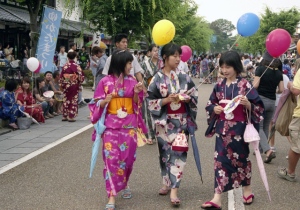
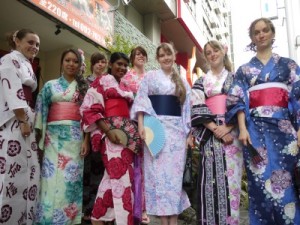
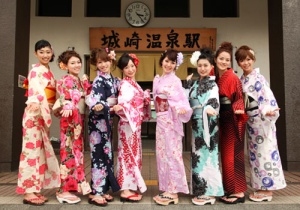
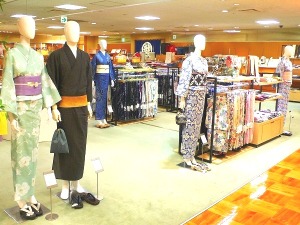
Source: http://japanese.about.com/library/weekly/aa081901a.htm
